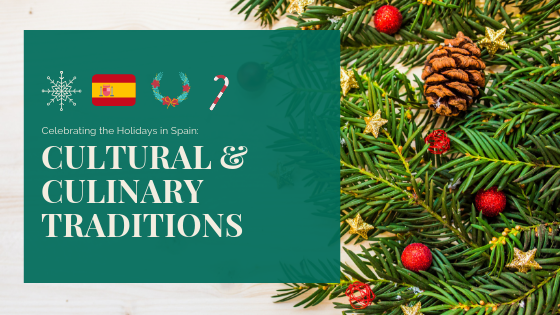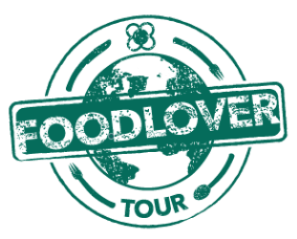CELEBRATING THE HOLIDAYS IN SPAIN: CULTURAL AND CULINARY TRADITIONS

The holidays are here and there’s no better place to spend them than in Spain! This country takes their holiday season seriously, trying to fit as much as possible in between December 24th and January 6th. Let’s take a look at the holidays in Spain during the Christmas season, as well as the cultural and culinary traditions that go along with them!
Christmas Eve & Day
Historically, Spain is a Catholic country, so Christmas is a very important time in Spanish culture. It’s a beautiful time of year as most cities lines their streets with Christmas lights and decorations. All throughout the holiday season you can enjoy strolling the streets and looking at the sparkling lights. Many shops and homes will set up a nativity, or belén, in their windows. These nativity scenes are very intricate and detailed and may contain dozens of pieces. There are also special Christmas songs, called villancicos, that children sing for school or church concerts.
As you can imagine, there are many traditional foods people eat during the holidays in Spain. On December 24th, Nochebuena, families gather to have a fantastic meal together, filled with simple, yet mouth-watering Spanish delicacies. There is always Spanish ham, grilled prawns, aged Spanish cheeses, crusty bread, and so much more. On the 25th, prepare yourself for more eating, as there is often a family lunch which can typically include seafood, roasted lamb, and veggies. Some sweet treats include turrones, or nougats, and polvorones, Christmas cookies with a dusty texture (where they get their name from).
New Year’s Eve & Day
New Year’s Eve is all about luck in Spain. Tradition says that you need to eat a bowl of lentils for lunch to have wealth and luck in the new year. The lentils are round like coins, so it’s like you’re eating a bowl of coins! You should also wear red, a lucky color in Spain.
On December 31st, Nochevieja, family and friends gather together for dinner and to enjoy the last night of the year together. As midnight approaches, each person takes a small dish with twelve grapes counted out. During the last twelve seconds of the year, each person eats one grape per second until the clock strikes twelve. This tradition goes back generations and is thought to bring good luck to those that eat all the grapes. Following the grapes, everyone brings in the new years with a glass of cava, Spanish champagne. Not a bad way to bring in the new year!
New Year’s Day is a day to rest and recover from the previous night’s festivities. Many families get together again for another leisurely, yet, delicious lunch. Again, typically meat or seafood dishes are common, dishes that you might only have on special occasions.
See more: What to Do in Madrid to Enjoy the Holiday Season
Los Reyes
Santa Claus doesn’t bring presents to children in Spain on December 25th, but rather the 3 Kings bring their haul on January 6th, Epiphany. In almost every city in Spain there is a parade on January 5th to celebrate the coming of the kings. Bring a bag with you since almost every float or performer in the parade throws out small candies to the crowds! By the end, you’ll have a pocketful of tasty treats. Later at night, children leave out milk and snacks for the kings and their camels as they eagerly await their presents.
The next day is the most exciting of the year for children as they dive into their piles of presents. In the afternoon, everyone partakes in a slice of roscón de reyes, or special cake for 3 Kings Day. This cake is a giant ring of fluffy cake with cream in the middle and candied fruits on top. Inside, a small figurine of baby Jesus and a lima bean are baked in. The person who finds the figurine will have good luck throughout the year, according to tradition. The one who finds the lima bean has to pay for the cake next January 6th!
Bonus: Caga Tió & Sant Esteve in Catalonia
In Catalonia, they love to squeeze in even more festivities during the holidays in Spain! One famous tradition is that of Caga Tió, an age-old Catalan holiday tradition. Families with children have a hollow log with a face and a red cap and stands up on four sticks. From December 8th onward, children have to take care of Caga Tió by feeding him snacks and covering him with a blanket to stay warm. By Christmas Day, he has grown so much from eating that he needs to defecate (where his name comes from, in Catalan). So, the children take sticks and hit Caga Tió with a stick while singing the traditional song to him until he defecates. The blanket is removed and little gifts and trinkets that he has defecated surround him. This sounds crazy, but it’s a real tradition!
Additionally, December 26th is a holiday in Catalonia. Boxing Day, or Sant Esteve, locally, is another family day to rest and recover from Christmas and eat leftovers. Back in the day, family would come over for Christmas and stay the night since the weather can get quite cold and snowy in Catalonia. On Sant Esteve, many families eat the leftovers from Christmas Eve and Christmas Day. The best way to use up the leftovers is to make canelons, pasta tubes that are filled with meat, veggies or seafood and covered in creamy bechamel. Pop them in the oven until they are golden and you’re ready to feast (again)!

